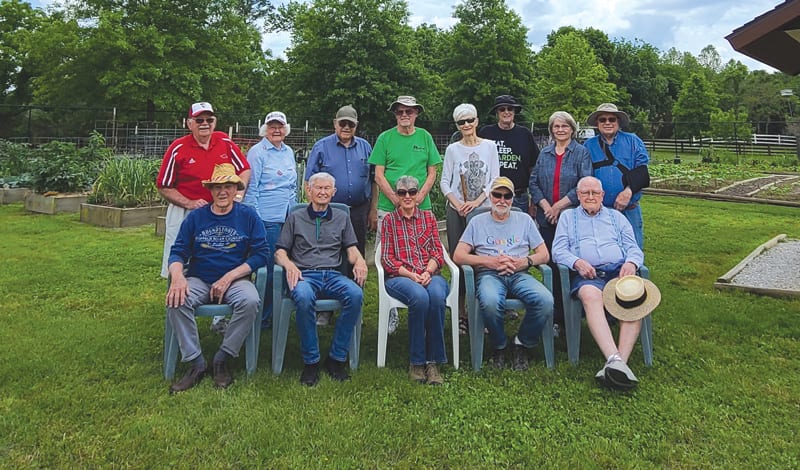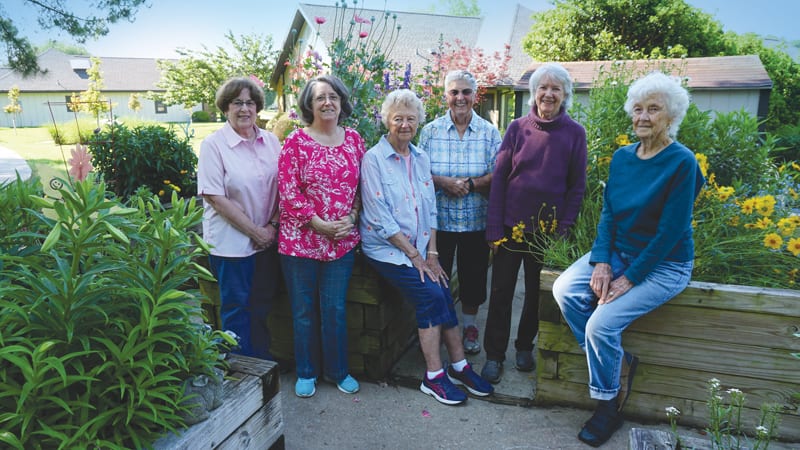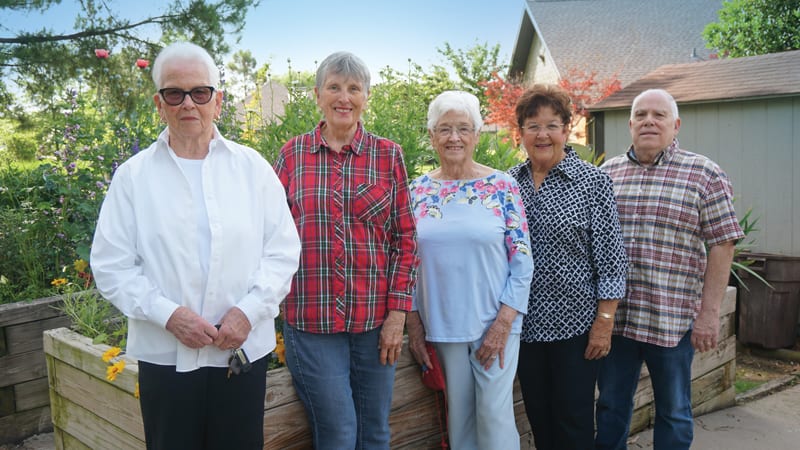BTV Communal Gardens are Bountiful Touchpoints to Nature
Since they were first planted on campus, the Community and Raised Bed Gardens have grown into something beautiful at BTV, providing sustenance, camaraderie, and a connection to nature for the residents who tend to them.

Community Gardeners: Top row, left to right: Ron Talbert, Faye Edmondson, Jim Young, Frank Price, Deb Santeford, Bob Hendrix, Bonnie Ashlock, Lanny Ashlock. Bottom row, right to left: Charles Stills, Gary Gray, Grace Donoho, Bob Bender, Richard Wharry. Not photographed: Lyle Gohn, Ardith Wharry, Sam & Inez Thornton, Rosa Lee Layne, Ed Piper, Jim Hunt, Thermon Crocker, Bill Martin
More than 30 residents tend to individual beds or plots at BTV’s two major gardens: the Community Garden at the southeast edge of campus, and the Raised Bed Gardens, in the heart of the Village near the gazebo.
Started by residents themselves in the 1990s, both gardens are rooted in friendship and social connections and complement the 44-acre Village campus as an oasis for wildlife and nature.
Comprised of 28 garden plots tended to by 18 residents, the Community Garden grows virtually every category of vegetable available in the U.S., according to Jim Hunt, a resident who oversees the garden and chairs the BTV Garden Committee.
Each year, the garden produces between 50-75 tomato plants, as well as corn, green beans, okra, chard, broccoli, strawberries, peas, larger flowers and more.
“There’s no limit on what we grow – it’s more about what we don’t grow,” Hunt said. “Tomatoes are probably the most popular, but personally, I’ve got Bok Choy out the ears. All of us grow excessively, and give away much more than we can freeze and use.”
A portion of what is grown at both gardens is sold at the BTV Farmers Market to help support the Foundation Garden Fund.
Hunt said it’s up to residents to care for the gardens, to include making repairs and purchasing communal supplies.
“It’s where we pontificate,” Hunt said with a chuckle. “Gardening is a good outlet for retired people, and we’ve got an exceptional group here. The camaraderie is really great, and it’s a lot of fun.”

Raised Bed Gardeners: Left to right: Barbara Brannan, Linda Hayes, June Davis, Judy Doyle, Karen Crocker, Mary Cotton. Not photographed: Margaret Fox
Raised Bed Gardens
The Raised Bed Gardens are located south of the main building next to the gazebo, along the sidewalk to the Lodge.
Each bed is encased in wood and raised to waist level, said resident Judy Doyle, the garden overseer for the past 11 years. Raised bed gardening eliminates the need to bend over and is preferred by some residents.
The gardens grow a variety of flowers such as bluebonnets, zinnias, poppies, irises, lilies, daisies and moonflowers – as well as a few small vegetables.
One bed is devoted to milkweed for bees and butterflies, supporting BTV’s role as a Certified Wildlife Habitat, Doyle said. The gardens also host multiple bird feeders, providing a quiet place to sit and watch nature.
“So many residents tell me what a joy it is to look down on the gardens and see how beautiful they are,” she said. “A lot of people will also take their walks through the area just to enjoy the flowers.”

Raised Bed Gardeners: Left to right: Char Olsen, Grace Donoho, Earlene Henry, Wyvern Beach, Vernon Collins
